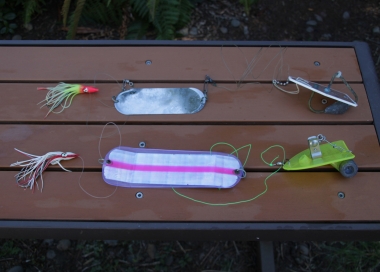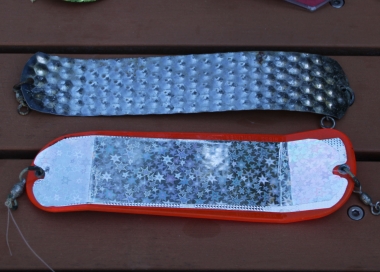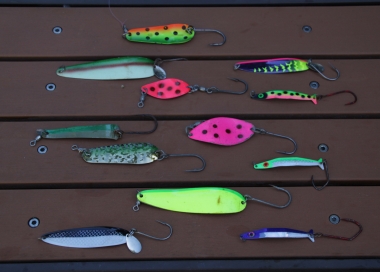
10 tips for targeting ocean coho
Some anglers think coho are more aggressive and easier to catch while they’re still in the open waters of the ocean. Here are some tips for targeting coho on big water.

Coho can aggressive and acrobatic – two qualities that make them an attractive target to anglers.
Eric Schindler, ODFW ocean salmon project leader, is a consummate ocean coho angler and offers these tips for ocean coho fishing.
1. Look for the right spot to fish – Water temperature
Off Oregon, the best coho salmon fishing is usually in ocean waters with a surface temperature of 52-56oF. That is, the temperature before the sun starts to warm the surface for the day. If you can’t find temperatures in that range, you might still catch coho. You may just work a little harder.
2. Look for the right spot to fish – Feed conditions
Look for “trash lines” and current edges at the surface. These edges tend to concentrate plankton and the small fish that feed on plankton… and the bigger coho that feed on the smaller fish.
3. Don’t go too deep
My favorite place to run my gear is in the propwash. I let out just enough line so my gear drops just below where I can see it -- usually 6-12 feet down. If that isn’t producing, then try running gear deeper, but usually coho salmon are feeding closer to the surface.
4. Gear – Diving planes, weights, downrigger
At times you can catch coho dragging a flashy salmon fly right on the surface. However, I like to have my gear running just deep enough that I don’t see it. By far the most common method to get gear a little deeper has been a diving plane. There are a lot of different diving planes and common ones include the “Deep Six,” “Delta Diver,” “Pink Lady” and “Dipsy Diver.”
Having a shiny and colorful diving plane will help attract coho as well. I tend to use chartreuse or pink for the diving plane, but have never noticed any measurable difference. Maybe I should get a new color like silver.
5. Keep your gear active – trolling speed
When targeting coho salmon, go fast! This is one of the most common failures by recreational anglers when targeting coho when using spoons or hoochies (I’ll get to those in a minute). You will want to be trolling at 3.5-6 mph. If you’re using whole or plug cut bait, you may need slow down a bit so you don’t tear up the bait.
6. Keep your gear active – flashers and dodger and other attractors
Flashers and dodgers are silver or brightly colored bent metal or plastic panels added behind the diver/weight/downrigger ball to add motion to your lure or bait, and also to “flash” and “pulse” in the water to attract fish to your gear. Flashers make a loop in the water, while dodgers swing back and forth from side to side.
There are also other attractors that will spin creating the flash and pulse, but without adding motion to the lure or bait. I usually stick with a small to medium size dodger in silver, but I know that all of the different attractors work. If I am fishing deep for Chinook, then I am more likely to use a larger flasher.
7. Keep your gear active – leader lengths
Running shorter 12 to 18-inch leaders between your flasher/diver and your lure/bait will add more motion to your gear, and is usually just the ticket for coho. Longer leaders up to 36” are typically going to be more effective for Chinook.
Leader length between the diver or weight and the gear should be 36-48 inches. Also, if you use heavy leaders during the hatchery-only seasons, it’s much easier to grab the leader when the fish is near the boat and release it while it’s still in the water.
8. Lures and baits – hoochies
Hoochies are the soft plastic lures that look like colorful squid. They come in countless colors and several sizes. In rigging a hoochie, I like to thread a hard head onto the leader, often in front of several beads ahead of the hook before threading the hoochie onto the leader. This will keep your hook hanging back a bit and help to avoid missing strikes. I prefer to use a single large hook (barb pinched down), and tip the hook with a piece of herring or anchovy.
As for the best colors of hoochie, I think I have caught coho on almost every color I have in my tackle box. However, I would recommend having hoochies in both the 2 ½” and 4 ¾” sizes, with at least some pink and chartreuse in the mix. It seems that the latest trend threading a spinner blade onto the leader in front of the hoochie. I haven’t tried it yet, but I am sure it wouldn’t hurt.
9. Lures and baits – spoons
Like with hoochies they come in unfathomable number of colors and sizes. For whatever reason, I like the “watermelon” color patterns on spoons -- probably because a slice of watermelon goes well with the coho off the grill…. (Sorry, I seem to have lost focus.) While I certainly catch coho (and Chinook) on the watermelon pattern spoons, but there are plenty of other colors that work.
The general rule is that you don’t use a flasher or dodger with a spoon, and you don’t tip the hook on your spoon with bait. Both of these will change the action of the spoon. However, if a plain spoon isn’t working, don’t be afraid to run them behind a flasher or dodger, or tip them with bait. Sometimes that’s just the ticket.
10. Change it up
Nothing works every day, so don’t be afraid to switch things up if you aren’t getting bites and others around you are. Change your trolling speed, change your direction of trolling, change your depth, change your attractors and lures. Or, simply pull your hair out and start over.
I always like to make sure I’m doing something a little different than the other anglers on the boat until we find the right something that is going to work that day.
BONUS TIPS
A little more advice on how to get that fish you hooked all the way to the boat. Coho are just plain crazy! They will jump, charge the boat (actually they’re just trying to run away from the diver and attractor), and do all kind of things that will result in a thrown hook and a lost fish.
- Don’t pick the rod up and then lower the tip and yank back. You rarely need to “set the hook” on a coho. When trolling, the boat and the fish have already taken care of that part.
- Don’t raise the tip of the rod up. That is a sure-fire way to get that coho to jump. And a jumping coho is much more likely to become a lost coho.
- Keep tension on the line. Don’t drop your rod tip to gain line unless you are reeling the whole time.
- If you think you lost the fish, reel like mad! Coho will often run towards the boat and give you the sense that you lost them -- maybe you did or maybe you didn’t.
If you decide not to keep a fish -- perhaps you caught a wild fish during a hatchery fish only season -- here are some tips for safely releasing it.
Most importantly, when you do go fishing, be safe and have a good time. Oh, and don’t forget to serve watermelon with your coho.
Eric Schindler served as the ODFW ocean salmon project leader.





